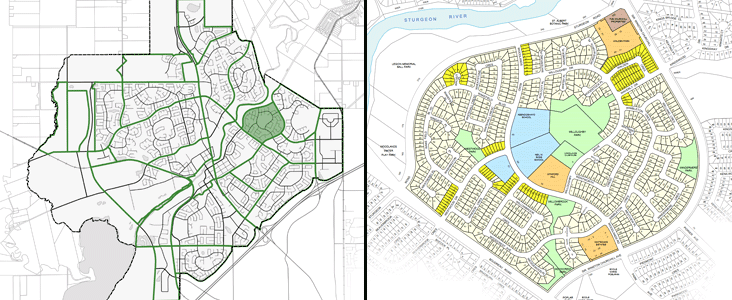Woodlands

Is it a coincidence that the neighbourhood of Woodlands is when seen from an aerial view, shaped like a leaf? The west side of Woodlands overlooks St. Albert Botanic Park, Legion Memorial Ball Park, Woodlands Water Play Park, and the Sturgeon River – not to mention the six large green spaces seen throughout the neighbourhood. If you want urban living in a natural setting, Woodlands is your community of choice.
Woodlands has a population of ~2,575, with an average age range of 40.80. Low-density residential homes form the majority of the zoning, but pockets of medium density housing are found on the north side, south side, and middle of the neighbourhood. The median house price is currently $341,950. There are two schools in the middle of the neighbourhood, as well as plenty of access to beautiful parks throughout.
St. Albert Transit (StAT) services Woodlands with weekday local routes, access to weekday commuter routes to Edmonton, and Dial A Bus.
About Woodlands
Development began: 1970s
Type of homes: Single detached homes, apartments, condos, and townhouses
Parks in the area: Westwood, Willowbrook, Woodcrest, Windermere, Woodlands Clubhouse, Willoughby
Schools in the Area
- Elementary: Keynooshayo, Leo Nickerson, Neil M. Ross Catholic Elementary School
- Secondary: Lorne Akins; St. Albert Public Outreach High School
Characteristics
- Home to the popular and community-focused Sturgeon Valley Baptist Church
- Easy access to the Woodlands Water Play Park
- Flanked by Sturgeon Road, Sir Winston Churchill Ave, and Boudreau Road, all major routes in the city
History
While Woodlands is known for being a welcoming, calm, and attractive neighbourhood, there was a time when the thought of Woodlands stirred up nothing but trouble! The issue was that St. Albert had attracted many residents during the 50s and 60s, and many people feared that if the Woodlands development went ahead as planned, it would turn St. Albert into an overpopulated city, rife with crime, and lacking in the necessary infrastructure supports.
It’s hard to believe it now, but it took many years before those for and against its development would reach a suitable compromise. But compromise they did, and construction of this neighbourhood began in the late 70s.
In the 80s, Sturgeon Valley Baptist Church was built. As the congregation did not have a home of its own before this and had to rely on meeting in gymnasiums, the church gave back to its community and opened its doors as a venue for both secular and religious groups in need of meeting space.
Another significant part of Woodland’s development came in 1992 with the opening of St. Albert Botanic Park. This beautiful and serene green space also functions as a place of plant science. Here is where a wide range of vegetation is collected, cultivated, and displayed with scientific names. The park also functions as a community hub that is run by volunteers.
Developing Woodlands turned out to be the right decision; few places in the city will you find a quieter, greener-focused, and milder-mannered neighbourhood.


